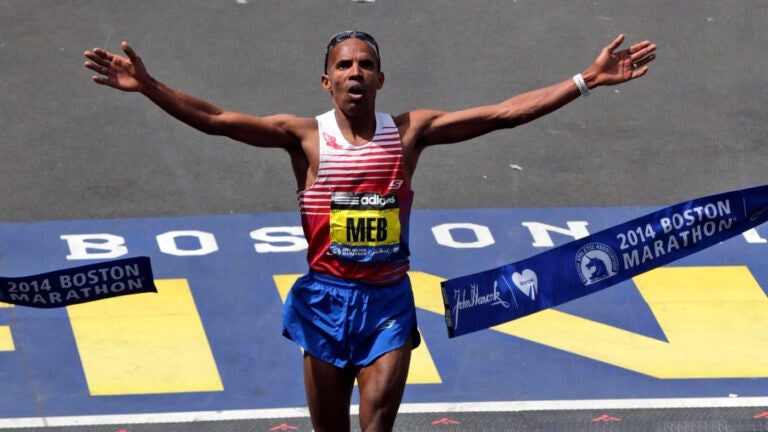Why Is A Marathon 26.2
Why is a marathon 26.two miles?
No 1 seems to agree on the specifics of the very specific distance.

Unlike other prestigious races, like the 100-meter or the 400-meter, the marathon stands out not merely because of its length, merely considering of its unusually specific distance. As any marathoner knows, the total altitude is 26.two miles. Boston Beer Co. even fabricated a Samuel Adams beer out of information technology.
-

The Boston Marathon is back. Volition you be watching?
Still, many runners—invariably some who will run in Boston this twelvemonth—have no idea why the marathon distance is 26.two miles (26.2187575 miles to be exact). The answer is somehow both straightforward and all the same mysterious.
The short reply is that marathons are set at 42.195 kilometers (26.2 miles) because the International Clan of Athletic Federations (IAAF) officially adopted that in 1921. Afterwards nearly 25 years of marathons stretching varying lengths, the 26.2-mile distance from the 1908 London Olympics was chosen as the standard.
Now, trying to explain exactly why the IAAF picked that specific Olympic course equally the official altitude—and why the London grade was its verbal length—is where the history becomes murky.
Equally an instance, even attaining a mere explanation as to why the IAAF chose the 1908 Games as its official measurement isn't possible. According to David Due east. Martin and Roger West.H. Gynn in The Olympic Marathon:
The race'due south length was given equally 42.1954 kilometers, or 26 miles, 385 yards—the same every bit at the 1908 London Olympic Games—but no discussion is provided regarding the rationale for its selection.
And as for the 1908 Olympic marathon, accounts differ on the caption for the class's weirdly precise length. What's indisputable is that the marathon began at Windsor Castle and ended in the Olympic Stadium in front of the purple box. However sources brainstorm to diverge in their accounts after that.
By the IAAF's version:
The altitude then was extended to the imperial measurement of 26 miles at the 1908 Olympic Games in London, and increased another 385 yards when the starting line was pulled back so it could be seen past the children in the Royal Nursery at Windsor and still terminate in front of Queen Alexandra at the White City Stadium in due west London.
David Miller'due south The Official History of the Olympic Games likewise provides the nursery every bit the reason for the boosted 385 yards.
Other experts disagree. Bob Wilcox of the International Society of Olympic Historians referred to the story nigh the 385 yards added because of royal children being able to sentry every bit a "myth," noting:
No evidence has been found to back up this story: nothing has been found in the purple athenaeum, and while Princess Mary started the race, there is stiff evidence, as will be seen, that this was a spur of the moment decision, and in any event, her influence made no departure to the distance.
Every bit was relayed in the official study of the 1908 London Olympics, the marathon class was described as proceeding:
From Windsor Castle to the Olympic Stadium in Shepherd'south Blitz, in which 385 yards were run on the cinder rails to the stop, below the Royal Box, the runner turning to his left as he entered the track on the side opposite the Royal Box.
Clearly, the lack of consensus on the origin of the route has persisted over the final 100 years.
Regardless of how the course length was determined, the 1908 race immediately became the about famous version of its day (which may aid to explicate why the IAAF eventually chose it as the official marathon length). Italian runner Dorando Pietri took a tardily atomic number 82 as he entered the Olympic Stadium. But afterwards initially turning the wrong manner downwardly the stadium'due south track, Pietri collapsed from exhaustion.
Controversially, he was helped to his feet and across the stop line by two race officials. The U.S. Olympic team, on behalf of second placed runner Johnny Hayes, protested the upshot. The protestation was upheld, and Hayes was awarded the golden medal later on Pietri was disqualified. Every bit a consolation, Pietri—who became a moral favorite among fans—was awarded a special cup by British Queen Alexandra.
Get the latest Boston sports news
Receive updates on your favorite Boston teams, straight from our newsroom to your inbox.
Conversation
This discussion has ended. Please bring together elsewhere on Boston.com
Why Is A Marathon 26.2,
Source: https://www.boston.com/sports/boston-marathon/2021/09/28/why-is-marathon-26-2-miles/
Posted by: valdeztrose1977.blogspot.com


0 Response to "Why Is A Marathon 26.2"
Post a Comment